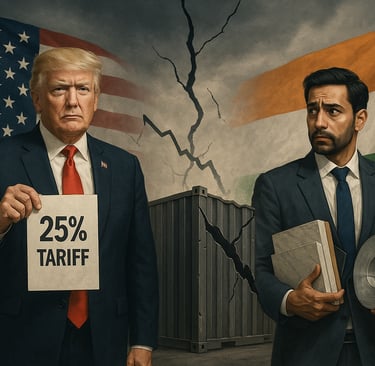The Impact of Trump's 25% Tariff on Indian Exporters
Trump’s tariff was a wake-up call. It proved that global trade is unpredictable, and Indian exporters must stay resilient, diversified, and digitally ready for long-term success.
Tejsingh Prajapat
8/1/20251 min read


Introduction to Trump's Tariff Policy
In 2018, President Donald Trump initiated a series of tariffs, the most notable being a 25% tariff on steel and aluminum imports. This decision was primarily aimed at protecting American industries but had far-reaching effects on global trade, particularly impacting countries like India. Indian exporters faced unique challenges due to the imposition of these tariffs, which significantly altered the dynamics of trade between the two nations.
Effects on Indian Exporter Sectors
Indian exporters, especially those in the steel and aluminum sectors, felt the immediate consequences of Trump's 25% tariff. The increased costs associated with exporting goods to the United States rendered Indian products less competitive in the American market. As a result, many exporters struggled to maintain their market share, leading to a decline in shipments and revenue. Moreover, sectors that relied heavily on raw materials from India, such as automobile manufacturing, faced disruptions, creating a ripple effect throughout the supply chain.
Adapting to New Trade Realities
In response to the tariffs, Indian exporters have begun to adapt their strategies to mitigate the impact. Some have focused on diversifying their markets, seeking to establish footholds in countries less affected by U.S. trade policies. Others have invested in enhancing the quality and value of their products to justify higher prices. Enhanced marketing strategies aimed at increasing visibility and presence in alternative markets have also become a focal point. Ultimately, these adaptations have enabled certain exporters to overcome some of the difficulties presented by the tariffs, although challenges persist.
To summarize, Trump's 25% tariff policy significantly affected Indian exporters, particularly in the steel and aluminum sectors. The immediate repercussions involved a loss of market competitiveness, leading to decreased sales and disruptions in trade. However, the resilience demonstrated by Indian businesses showcases the ability to innovate and adapt to a challenging global trade landscape. Moving forward, it will be crucial for these exporters to continue exploring new markets and strategies to thrive despite ongoing trade tensions.
ABOUT EXIMSEA
EximSea is a trusted exporter of premium quality marble and granite from Rajasthan, India. We deliver top-grade natural stones worldwide at the best prices, ensuring excellence, reliability, and customer satisfaction.
Empowering global trade for businesses worldwide.
+919079764119
© 2025. All rights reserved.
Contact Us
Location
Sodawas Ajarka Road, Todarpur Alwar, Rajasthan, India - 301401
